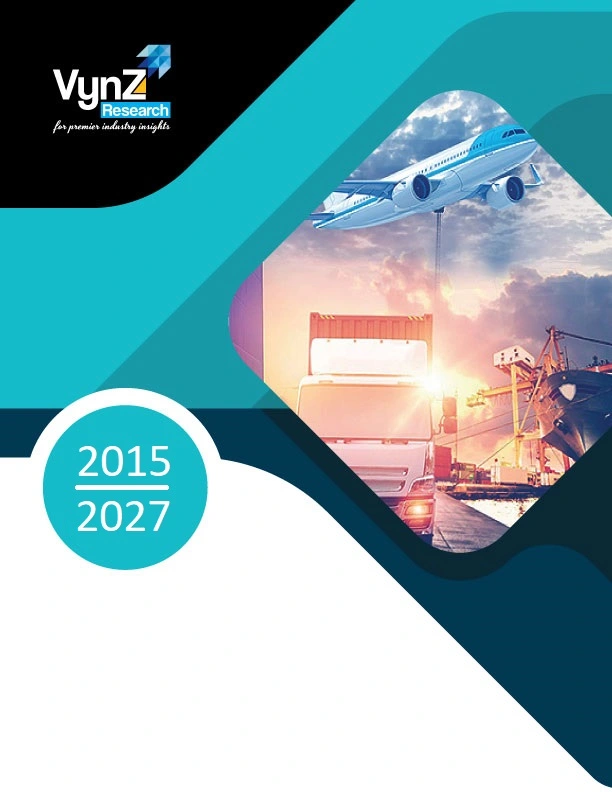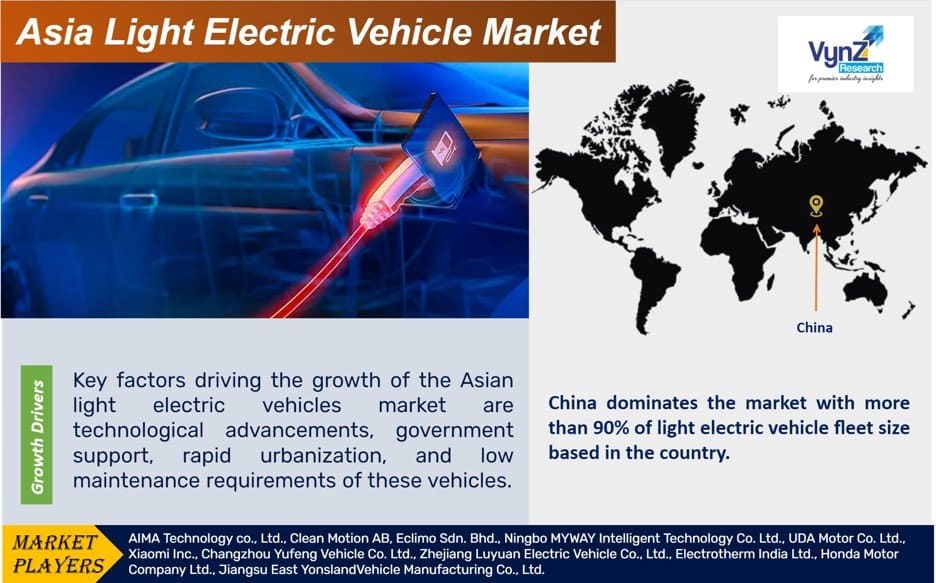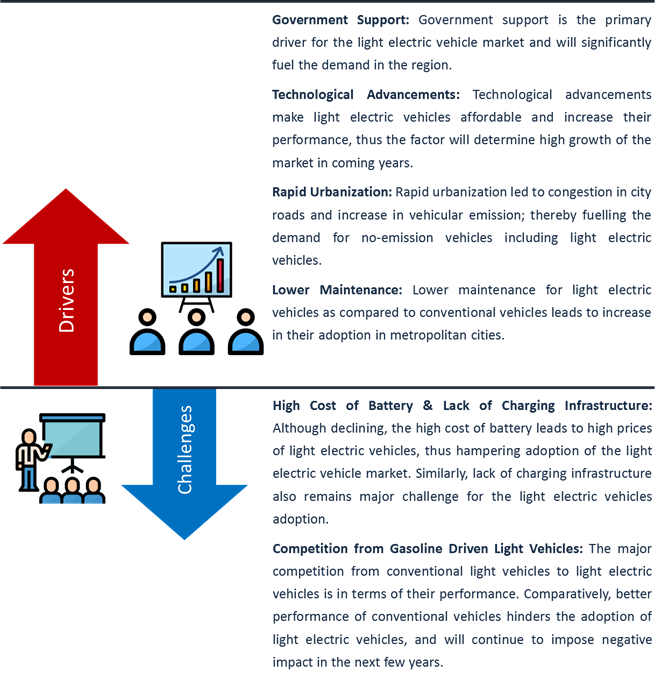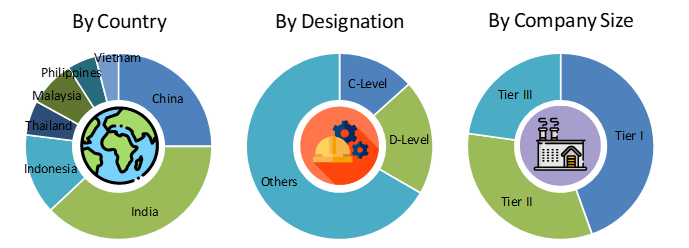| Status : Published | Published On : Nov, 2024 | Report Code : VRAT4033 | Industry : Automotive & Transportation | Available Format :

|
Page : 187 |

Asia Pacific Light Electric Vehicle Market Size & Share | Growth Forecast Report 2030
Industry Insights By Product (Hybrid Electric Vehicles(HEVs), Plug-in Hybrid Electric Vehicles (PHEVs), and Battery Electric Vehicles (BEVs)), By Voltage (24V, 36V, 48V, 60V, and 72V), By Application (E-Vehicles for Personal Use, Commercial Applications, Sports, Shared Mobility Solutions), By Battery (Lithium cobalt batteries (LCA), Lithium-ion polymer batteries (LiPo), and Nickel-metal hydride batteries (NIMH)), by Country (China, India, Indonesia, Thailand, Malaysia, Philippines, Vietnam and Rest of Asia)
Industry Overview
The Asian Light Electric Vehicle Market is predicted to grow at 8.0% CAGR during the forecast period with the market size reaching USD 54.8 billion by 2030.
Different products including e-scooters, e-rickshaws, and e-motorbikes are majorly contributing to the light electric vehicle market size in Asia. The market has witnessed significant demand for products and services over the last few years due to technological advancements, government support, rapid urbanization, and low maintenance requirements of these vehicles.

Asia Pacific Light Electric Vehicle Market Report Coverage
|
Report Metric |
Details |
|
Historical Period |
2018 - 2023 |
|
Base Year Considered |
2024 |
|
Forecast Period |
2025 - 2030 |
|
Market Size in 2024 |
U.S.D. xx Billion |
|
Revenue Forecast in 2030 |
U.S.D. 54.8 Billion |
|
Growth Rate |
8.0% |
|
Segments Covered in the Report |
By Product, By Voltage, By Application and By Battery |
|
Report Scope |
Market Trends, Drivers, and Restraints; Revenue Estimation and Forecast; Segmentation Analysis; Impact of COVID-19; Companies’ Strategic Developments; Market Share Analysis of Key Players; Company Profiling |
|
Regions Covered in the Report |
China, India, Indonesia, Thailand, Malaysia, Philippines, Vietnam and Rest of Asia |
Asian light electric vehicles Industry Dynamics
Asian light electric vehicles market Trends/ Growth Drivers:
Technological advancement and government support along with rapid urbanization contribute to the growth of this market
The increasing inclination towards e-mobility and the adoption of electric three-wheelers for public transport is the key trend observed in the Asian market. In the developing economies of Asia, a large population is dependent on public transport for their daily commute. Auto rickshaws are the major mode of transport in the major urban cities of these countries such as India and Thailand. Auto rickshaw provides cheaper and faster intracity transport in these countries; therefore, a large population depends on it for transport. Although they lower performance compared to conventional auto rickshaws, electric three-wheelers are still preferred for their low maintenance rate. Moreover, supported by government policies and subsidies manufacturers can provide these electric three-wheelers at competitive pricing, which further increases their adoption in the region.
Key factors driving the growth of the Asian light electric vehicles market are technological advancements, government support, rapid urbanization, and low maintenance requirements of these vehicles. Technological advancements in the electric vehicle industry have made light electrical vehicles affordable and increased their performance and efficiency. The major reason for the affordable prices of light electric vehicles is the advancement in battery technology. Conventional autorickshaw owners are adopting this e-rickshaw and e-auto for public transport as it saves the cost of maintenance. The urban population in Asia prefers scooters and motorcycles for their daily commute as it saves them time and cost. This fuels the growth of the Asian market.
ASIAN LIGHT ELECTRIC VEHICLE INDUSTRY DYNAMICS

Asia Pacific Light Electric Vehicle Market Challenges
The initial high cost and lack of charging infrastructure hinders the market
Key challenges faced by the light electric vehicle industry are the high cost of battery manufacturing, lack of charging infrastructure, and competition from high-performance gasoline-driven vehicles. The competition from the conventional vehicles is majorly in terms of its performance. Light electric vehicles have low power output and shorter distances covered, which makes these vehicles inefficient for long-distance travel.
Recent Developments by Key Players
Clean Motion (The electric vehicle manufacturer) has designed a premium luggage trailer for their solar-powered vehicle EVIG, where the trailer is going to be used for the transportation of luggage from NEOM Airport to Sindalah Island.
Xiaomi is pushing into the overseas market by selling lower-priced models of their new electric vehicle.
Asian light electric vehicles Market Segmentation
VynZ Research provides an analysis of the key trends in each segment of the Asian light electric vehicles Market report, along with forecasts at the regional and country levels from 2025-2030. Our report has categorized the market based on vehicle type, and application.
Insight by Product
- Two-Wheelers
- Three-Wheelers
- Four-Wheelers
Battery Electric Vehicles dominate due to their zero-emission operation
The Asia Pacific light electric vehicle market is bifurcated by product into Hybrid Electric Vehicles(HEVs), Plug-in Hybrid Electric Vehicles (PHEVs), and Battery Electric Vehicles (BEVs). Out of these segments, the most dominating subsegment is Battery Electric Vehicles (BEVs) mainly due to their zero-emission operation. These vehicles are also the best in compliance with the strict environmental regulations. This segment is expected to grow significantly during the forecast period due to the rising preference among consumers for eco-friendly transport options, especially in urban commuting.
Insight by Application
- Personal Use
- Commercial
Personal Use Vehicles segment will grow due to higher demand
Applications divide the Europe light electric vehicle market into E-Vehicles for Personal Use, Commercial Applications, Sports, and Shared Mobility Solutions. Among them,the personal use vehicles segment is dominating and will grow more due to higher demand which is attributed to their sustainability, convenience, eco-friendliness, higher preference forremote work, rapid urbanization, rising commercial applications, and cost-effectiveness.
Insight by Voltage
- 24V
- 36V
- 48V
- 60V
- 72V
48V and 72V segmentsdominate due to higher power supply
The Asia Pacific light electric vehicle market is divided by voltage into 24V, 36V, 48V, 60V, and 72V categories. Among all these segments, the most dominant subsegments are 48V and 72V because these can meet higher power requirements and supply more power to enhance the performance electric vehicles across a wide range of applications. These segments are expected to grow mainly due to the growing demand as these utilize advanced battery technology for better power management.
Insight by Battery
- Lithium cobalt batteries (LCA)
- Lithium-ion polymer batteries (LiPo)
- Nickel-metal hydride batteries (NIMH)
Lithium-Ion Batteries dominate due to performance advantages
The types of battery divide the Asia Pacific light electric vehicle market into Lithium cobalt batteries (LCA), Lithium-ion polymer batteries (LiPo), and Nickel-metal hydride batteries (NIMH) categories. Among them, the Lithium-ion batteries segment dominates due to higher efficiency, energy density, and life.
Asia Light Electric Vehicle Market: Geographic Overview
- China
- Japan
- India
- South Korea
- Vietnam
- Thailand
- Malaysia
- Rest of Asia-Pacific
Among different countries, China dominates the market with more than 90% of light electric vehicle fleet size based in the country. India is the fastest-growing market for light electric vehicles, owing to the rapid adoption of electric three-wheelers over the last few years and increasing government support.
Competitive Insights of Asian light electric vehicles Market :
Market players in the light electric vehicle industry are investing capital to develop low-cost light electric vehicles with better performance to provide them with distinctive advantages.
AIMA Group produces and sells electric bicycles, electric tricycles, sightseeing vehicles (except automobiles), off-highway recreational vehicles (except automobiles), electric four-wheeled vehicles (except automobiles) and bicycles, sports equipment and its parts manufacturing, research and development, processing and assembly. Bicycle, electric bicycle,electric motorcycle and its parts sales and after-sales service.
Clean Motion AB develops and manufactures electric vehicles. The company provides EVIG, an electric delivery vehicle for cities and Zbee, a lightweight electric vehicle for transportation and goods.
Some of the key players in the light electric vehicles market are:
- AIMA Technology Co. Ltd.
- Clean Motion AB
- Eclimo Sdn. Bhd.
- Ningbo MYWAY Intelligent Technology Co. Ltd.
- UDA Motor Co. Ltd.
- Xiaomi Inc.
- Changzhou Yufeng Vehicle Co. Ltd.
- Zhejiang Luyuan Electric Vehicle Co. Ltd.
- Electrotherm India Ltd.
- Honda Motor Company Ltd.
- Jiangsu East Yonsland Vehicle Manufacturing Co. Ltd.
- Jiangsu Xinri E-Vehicle Co. Ltd. (SUNRA)
- Viar Motor Indonesia
- Yadea Technology Group
- STAR 8 AUSTRALIA PTY LTD
- Jiangsu Kingbon Vehicle Co. Ltd.
- Hero Electric Vehicles Pvt. Ltd.
- Terra Motors Corporation
- TukTuk Factory
The Asia Light Electric Vehicle Market report offers a comprehensive market segmentation analysis along with an estimation for the forecast period 2025–2030.
PRIMARY RESEARCH INTERVIEWS - BREAKDOWN

Frequently Asked Questions
Purchase Options
Latest Report
Research Methodology
- Desk Research / Pilot Interviews
- Build Market Size Model
- Research and Analysis
- Final Deliverabvle
Connect With Our Sales Team
- Toll-Free: 1 888 253 3960
- Phone: +91 9960 288 381
- Email: enquiry@vynzresearch.com
Asia Pacific Light Electric Vehicle Market
